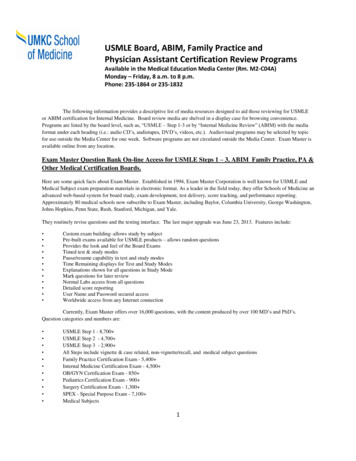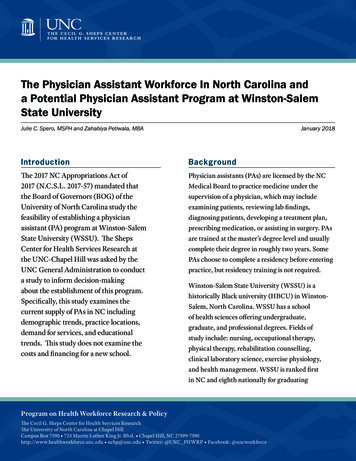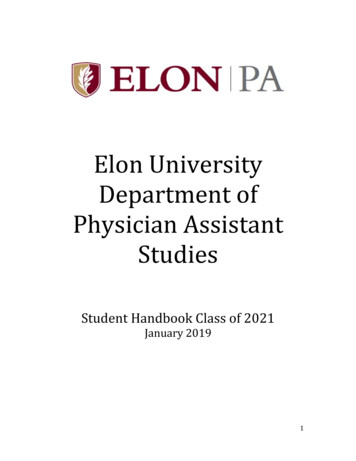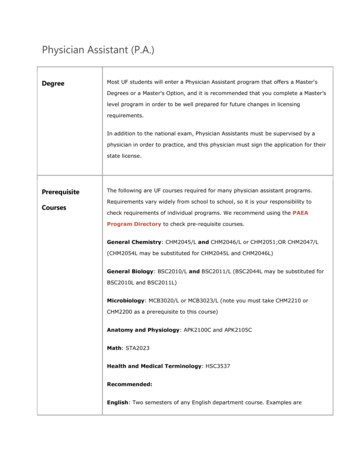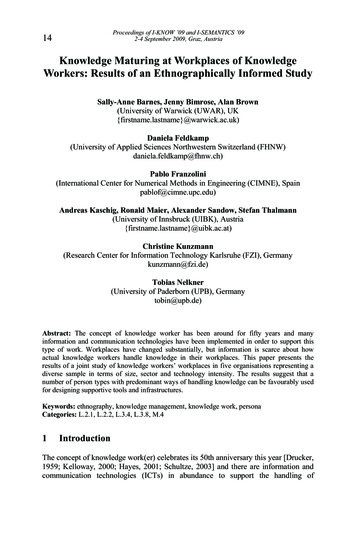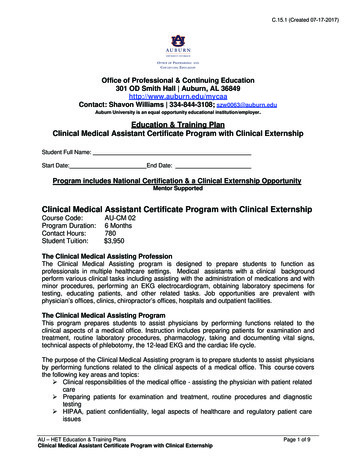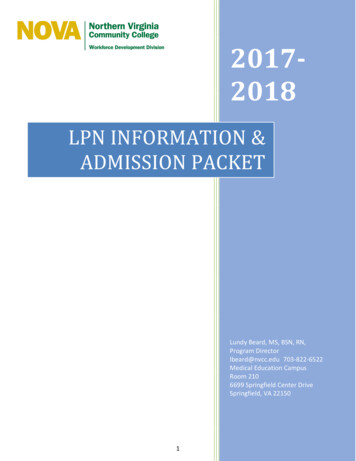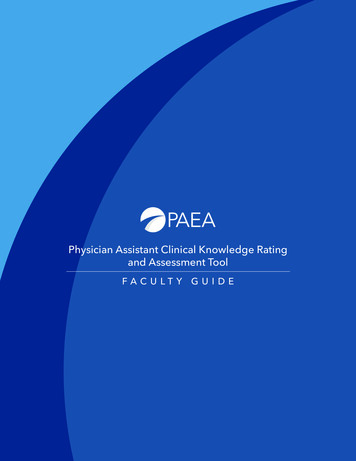
Transcription
Physician Assistant Clinical Knowledge Ratingand Assessment ToolFAC U LTY G U I D E
Table of ContentsPREFACE3CONTACT US4SECTION 15Statement of PurposeBackground55SECTION 2 — Exam Development & Construction MethodsPool AnalysisTest ConstructionContent ValidityBlueprintItem FormatItem Analysis and Key ValidationProject Planning and QualitySECTION 3 — Scoring & Analytical ReportsStatement of PurposeScoring and InterpretationSample ReportsImportant Considerations666667881010101120SECTION 4 — Research on the PACKRAT Examination21REFERENCES23GLOSSARY OF TERMS24APPENDIX A — PACKRAT Exam Blueprint27APPENDIX B — PACKRAT Topic List28APPENDIX C — Core Tasks & Objectives39 2020 PAEAPAEA PACKRAT Faculty Guide2
PrefaceDear Members,This year—2020—marks a major milestone for the PAEA PACKRAT exam. For 25 years, PACKRAThas helped students across the country assess their knowledge and has helped programs evaluatetheir curricula. Our work and experience creating PACKRAT has also been foundational in thedevelopment of the full suite of exams we offer today — PACKRAT, End of Rotation , and End ofCurriculum .As you may know, PACKRAT is an objective, comprehensive self-assessment tool for student andcurricular evaluation typically offered at important transition times for PA students, most commonlyat the end of the didactic and clinical phases of training.It is important to note that there is no pre-set passing score for PACKRAT exams. The PACKRATexam was developed as a student self-assessment and should be used as such. Programs arecautioned against interpreting the scoring and analytical reports outside of the statement of purpose.Specifically, PAEA explicitly discourages programs from using the PACKRAT exam for gradingpurposes or as a summative evaluation.This guide offers faculty information on the PACKRAT exam, including how its blueprint, guidingprinciples, topic list, exam items, and core tasks and objectives were created, and the continuousscientific review that occurs with each version. Furthermore, it touches on the exam’s overallconstruct validity.We hope you find this guide helpful and appreciate your continued participation in PAEA. Should youhave additional questions, feel free to contact me directly at oziegler@PAEAonline.org.Sincerely,Olivia ZieglerChief Assessment Officer 2020 PAEAPAEA PACKRAT Faculty Guide3
Contact UsIf you have any questions, please contactthe Assessment Team at 301-617-7820 orexams@PAEAonline.org.Exam Support is available8:00 a.m. – 8:00 p.m. ET, Monday – Friday.EDITOR IN CHIEFKim Cavanagh, DHSc, PA-Cassessmenteic@PAEAonline.orgCHIEF ASSESSMENT OFFICEROlivia Ziegler, MS, PAoziegler@PAEAonline.orgASSESSMENT & EVALUATION SPECIALISTDenise Rizzolo, PhD, PA-Cdrizzolo@PAEAonline.orgDIRECTOR, ASSESSMENT & SECURITY OFFICEREmily Yunker, MPA, PMP, CSMeyunker@PAEAonline.orgRELATIONSHIP COORDINATORChiquita Careyccarey@PAEAonline.orgDEVELOPMENT MANAGERJulien Williamsjwilliams@PAEAonline.org 2020 PAEAPAEA PACKRAT Faculty Guide4
SECTION 1PACKRAT ExamSTATEMENT OF PURPOSEThe Physician Assistant Clinical Knowledge Rating and Assessment Tool or PACKRAT is an objective,comprehensive self-assessment tool for student and curricular evaluation.BACKGROUNDThe PAEA PACKRAT exam is used by more than 95% of PA programs nationwide. Each examconsists of 225 new items, all used operationally. National performance data is released after 300student administrations.The exam is built using a two-dimensional content blueprint and topic list developed by experiencedPA educators and national exam experts, specifically for PA students. All exam items are written andevaluated by PA educators as part of a rigorous multi-level peer review process.PACKRAT can be delivered in a proctored or unproctored environment, on-site or remote, through asecure, password-protected website. Item order is randomized for each student, though each studentsees all 225 items. The recommended completion time is one minute per question or 3.75 hours total;however, more time can be given to a candidate at the discretion of the program. The exam is a fixedlength linear test. All exam items are multiple choice questions with four or five answer options andeach with only one correct answer.Each educational institution is provided information about its students and the overall mean score andstandard deviation of all examinees nationwide. It is then up to each institution to determine how itwill use the scores. The exam items discriminate well between high- and low-performing students. Thereliability of the exam is high. 2020 PAEAPAEA PACKRAT Faculty Guide5
SECTION 2Exam Development & Construction MethodsPOOL ANALYSISBecause each version of PACKRAT is comprised of completely new items, there is not a traditional item poolto analyze.TEST CONSTRUCTIONThe test is constructed using all of the items that have successfully completed peer-review. One formis built to blueprint specifications each year and is balanced for content (organ system) and task areas.In the event that there are not enough new items or there is a blueprint imbalance items from previousPACKRAT exams are used to complete construction.CONTENT VALIDITYContent validity refers to the extent to which an exam measures the knowledge it was designed tomeasure (Almanasreh, Moles, & Chen, 2019). PACKRAT’s content validity is determined by the contentexperts who write and review items for the exam using their expertise as PA educators. From there,several review steps occur before an item makes it onto a live scored form, including small-group peerreview and a full-committee peer review. Once an item has made it on to a form, it is reviewed again viaa thorough form review process. Post-administration, items that do not perform well statistically arereviewed to ensure there is only one correct answer and no other content flaws are present.BLUEPRINTContent AreasThe PACKRAT blueprint (Appendix A) is two-dimensional, meaning that it is organized both by content andtask areas. Each PACKRAT exam is built to blueprint and topic list specifications (Appendix B). Questionsincluded on the exam are considered only a sample and may not reflect all content topics identified in thetopic list. Questions developed for PACKRAT reflect the diverse group of patients whom PAs will be calledupon to treat.To learn more, visit: Core Tasks And ObjectivesCore Tasks and Objectives (Appendix C) are assessed by all of the PAEA examinations (PACKRAT, Endof Rotation, and End of Curriculum) and should be provided to students to aid in their preparation forPACKRAT.To learn more, visit: s/ 2020 PAEAPAEA PACKRAT Faculty Guide6
SECTION 2EX AM DEVELOPMENT & CONSTRUCTION METHODSGuiding PrinciplesThe PACKRAT exam was developed as a student self-assessment and should be used as such. It shouldnot be used for a grade or as a summative exam, as that is not the intended purpose of the PACKRAT. Theexam can also assist programs with their programmatic and curricular self-assessments as well.PACKRAT is intended to mark important transition times for PA students, most commonly at the end ofthe didactic and clinical phases of training. National comparative statistics for both year one and yeartwo students are provided on score reports. Combined national comparative data for retired versionscan be found on our website.ITEM FORMATThe PACKRAT exam uses a ‘one best answer’ format. Each item consists of a scenario or vignette (knownas a stem), a question (known as a lead-in), and a list of potential solutions. The list of solutions consists ofone correct or best answer (known as the key) and incorrect or inferior alternatives (known as distractors).Each item on the PACKRAT exam includes a clinical vignette with a varying degree of complexity.Vignettes are a good measure for assessing higher-order thinking skills, and they provide a betterapproximation of real-life practice (National Board of Medical Examiners, 2016).The following vignette is a sample item consistent with those on the PACKRAT exam:A 6-year-old girl is brought to the Emergency Department by her parents with a severesore throat for the past four hours. Past medical history reveals immunizations are not upto date. Temperature is 39.0 C (102.2 F), pulse rate is 120/minute, and respirations are24/minute, labored with intercostal retractions and stridor. Physical examination revealsan irritable, ill-appearing child leaning forward with her neck hyperextended and chinthrust forward.Which of the following immunizations is most likely to have prevented this condition?DISTRACTORSA. Diphtheria, tetanus, and acellular pertussis (DTaP)B. Haemophilus influenza type b (Hib)C. Inactivated influenzaITEM STEMLEAD-INKEYD. Pneumococcal conjugate (PVC13)Note the structure of the stem and potential options. All of the items on our exams are coded to theblueprint and topic list; the coding for this specific item is as follows:Content Area:ENT/OphthalmologyTask Area:Health MaintenanceDiagnosis:Epiglottitis 2020 PAEAPAEA PACKRAT Faculty Guide7
SECTION 2EX AM DEVELOPMENT & CONSTRUCTION METHODSITEM ANALYSIS AND KEY VALIDATIONA PACKRAT exam does not have both operational and pre-test items. Rather, each item is operationaland scoring is characterized as the number of questions answered correctly. PAEA performs ongoinganalyses of operational PACKRAT items to ensure that they are meeting expectations, and to identifystrong items that can be placed in our PACKRAT item pool. The item analysis is conducted usingclassical test theory principles in order to flag items for key validation.PAEA uses three flagging criteria to identify items for review. p-value 0.35: Difficult items, those where 35% or fewer students answered correctly, are flaggedfor review. pbis 0.1 and p 0.9: Items with low discrimination that are not also easy are flagged for review.(Easy items, by their nature, do not discriminate well between low and high performers, as theclear majority of students answer the item correctly. Easy items are not flagged). key pbis distractor pbis: Items with distractors that exhibit better discrimination than the keyare flagged for review. These items have at least one incorrect answer option that appearsplausible to high performers; sometimes these items are mis-keyed, or they may have more thanone correct answer.The point-biserial correlation coefficient (pbis), sometimes referred to as point biserial or discrimination,is used to measure the ability of an item to distinguish between high and low performers. A high pbismeans that high performers are more likely to answer an item correctly than low performers. A negativepbis means that low performers are more likely to answer an item correctly than high performers.Too many low or negative point biserial items on an exam will reduce the overall reliability of theinstrument. Note that PACKRAT items, because this is the first time they have been administered, areheld to a higher standard than operational items on other exams that have seen more administrationsand have passed through the flagging process at least once before.Items flagged after the administration of each PACKRAT exam version are reviewed by a small groupof PACKRAT item writers in a key validation meeting. Prepared materials for these meetings includea display of each item to be reviewed and a collection of relevant statistical information for each item.Subject matter experts review each flagged item and decide whether to keep the item as-is (“accept”),mark the item as “rewrite,” or delete the item (“reject”). A psychometrician records the decision foreach item and assists with the interpretation of statistical information. This process continues yearlyafter the exam is published.PROJECT PLANNING AND QUALITYDeveloping a high-quality, national standardized exam is a significant endeavor. Multiple individualsand processes are involved, and a well-documented system of exam development is necessary to ensure 2020 PAEAPAEA PACKRAT Faculty Guide8
SECTION 2EX AM DEVELOPMENT & CONSTRUCTION METHODSquality. At PAEA, we utilize project management and quality assurance processes to ensure productiongoals are met and the quality of the PACKRAT exam is maintained through a systematic approach. 2020 PAEAPAEA PACKRAT Faculty Guide9
SECTION 3Scoring & Analytical ReportsSTATEMENT OF PURPOSEThe PACKRAT exam is an objective, comprehensive self-assessment tool for student and curricularevaluation. It is important that programs have a clear understanding of the characteristics, meaning,intended interpretation, and limitations of the PACKRAT scoring and analytical reports.Programs are cautioned against interpreting the scoring and analytical reports outside of thestatement of purpose. Specifically, PAEA explicitly discourages programs from utilizing thePACKRAT exam as a summative evaluation.SCORING AND INTERPRETATIONThe PACKRAT exam is administered more than 18,000 times each year. National comparative dataare available for each version of PACKRAT once 300 students have taken it, and those data areupdated weekly as more students take the exam. Data are available for year one students, year twostudents, and all students who took each version.PACKRAT is designed as a self-assessment tool for students. The exam may be given proctoredor unproctored and/or as an open- or closed-book examination. However, if it is unproctored oropen book, the PAEA honor code policies still apply to the exam administration. If the exam isdelivered in a unproctored environment, programs can set a testing window; for example, allowinga student to start the exam at any time over a several-day period. Programs can also determine theirown time limit for the exam up to six hours and 59 minutes plus time-and-a-half and double-timeaccommodations if appropriate. PAEA does not recommend or intend to recommend a passing gradeor int
task areas. Each PACKRAT exam is built to blueprint and topic list specifications (Appendix B). Questions included on the exam are considered only a sample and may not reflect all content topics identified in the topic list. Questions developed for PACKRAT reflect the diverse group of patients whom PAs will be called upon to treat.

